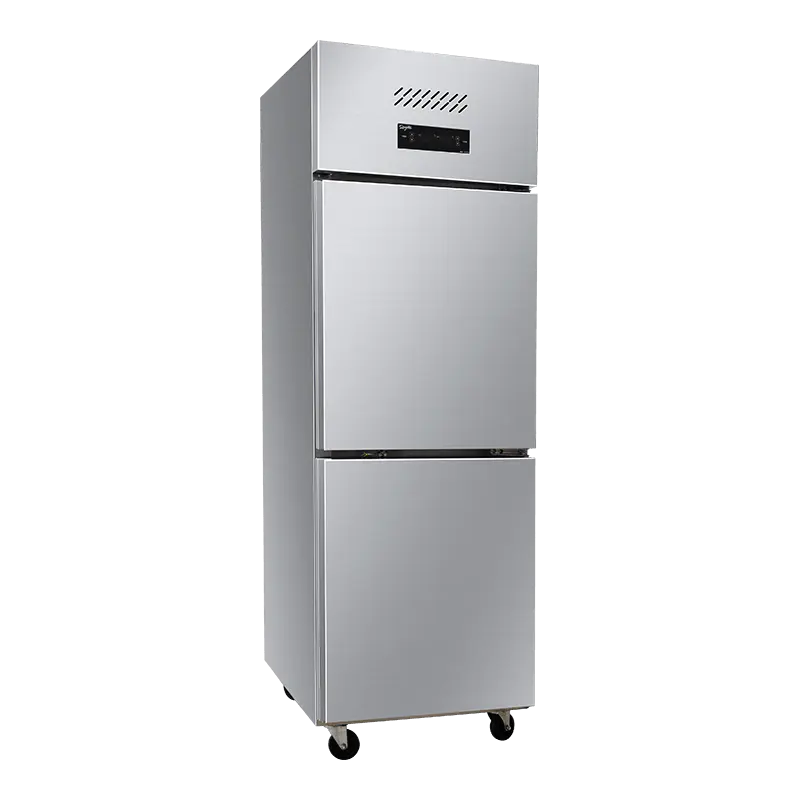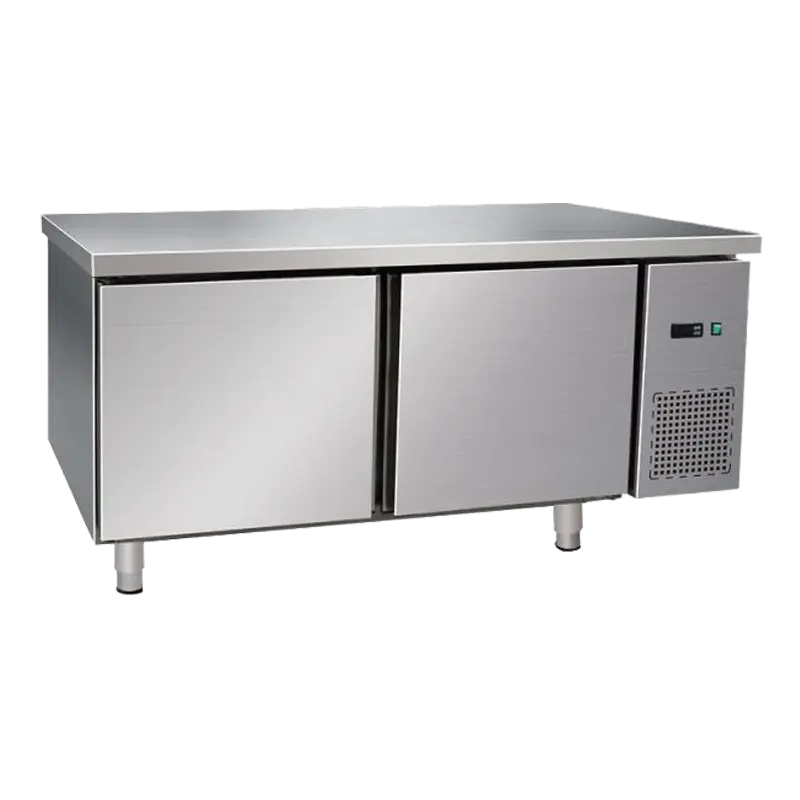This article focuses on selecting, sizing, installing, and maintaining commercial fridge units for professional kitchens, cafés, grocers, and convenience stores. It is practical and hands-on: no fluff — only what you need to choose the right equipment, reduce operating cost, stay compliant, and avoid downtime.
Choosing the Right Type of Commercial Fridge
Commercial refrigeration comes in multiple formats; pick a type that matches product, workflow, and space. Key types and where they work best are below.
- Reach-in upright refrigerators — ideal for restaurants and bars where vertical access and compartmentalized storage are required.
- Undercounter units — fit beneath worktops for prep stations and small kitchens; save floor space and shorten reach time.
- Walk-in coolers and freezers — used for bulk storage in high-volume operations; require planning for floor, drainage, and HVAC.
- Display cases (open or glass-door) — for retail and grab-and-go; prioritize product visibility, consistent temperature, and low energy bleed.
- Prep/chef units with drawers — for mise-en-place and rapid access; check gasket quality and drawer seals.
Capacity, Layout and Sizing
Correct capacity is about daily throughput, stock rotation, and peak demand, not only cubic feet. Oversize increases cost; undersize causes stock spoilage and operational delays.
How to size by usage
Estimate peak product stored at once (kg or liters) plus 25–30% buffer for deliveries. For walk-ins, plan clear aisle space and shelving runs so staff can access product without long door-open times.
Layout tip: place fridges by workflow
Put food-prep refrigeration adjacent to prep lines; place delivery-facing storage near loading docks. Minimize cross-kitchen traffic and repeated door openings.
Energy, Efficiency and Running Costs
Purchase price is one-time; energy consumption and maintenance often dominate lifetime cost. Evaluate annual kWh use, not just rated power. Modern inverter compressors and improved insulation reduce running costs.
- Look for energy performance data (daily or yearly kWh). Compare units at the same internal volume and test conditions.
- Variable-speed (inverter) compressors cut cycling losses in partial-load conditions common in many kitchens.
- LED lighting, high-quality door gaskets, and night covers for open display cases reduce waste.
Installation, Ventilation & Site Requirements
Proper placement and ventilation are essential for compressor life and cooling performance. Neglect these and you shorten equipment life.
Clearances and airflow
Observe manufacturer-recommended clearances on condenser panels. For remote condensers or rooftops, confirm structural capacity and run proper refrigerant piping with insulation to reduce pressure drop.
Electrical and drainage
Verify dedicated circuits, correct voltage, and surge protection. Walk-ins and some undercounter units need floor drains and condensate lines; slope floors toward drain points and provide trap/seal where required.
Materials, Doors, Shelving and Hygienic Design
Stainless steel interiors and exteriors improve durability and cleaning. Choose door types by use: solid doors retain temperature best; glass doors are for visibility but can increase energy use.
- Shelving: adjustable wire or corrosion-resistant epoxy shelves for airflow and sanitation.
- Gaskets: replaceable, molded gaskets and magnetic seals that compress evenly to avoid warm spots.
- Drainage: easy-access drains and removable drip trays simplify daily cleaning.
Controls, Monitoring and Temperature Management
Digital controllers, alarms, and remote telemetry (IoT) let you track temperature trends, get alerts on door open/close events, and generate HACCP logs for audits.
Recommended features
- Dual sensor monitoring (air and product) for accurate control.
- Alarm outputs and network connectivity for 24/7 alerts.
- Timed defrost or adaptive defrost depending on humidity and door cycle characteristics.
Maintenance, Cleaning and Sanitation Plan
A written preventive maintenance schedule prevents failures. Below is a practical weekly-to-annual checklist.
- Daily: wipe spills, check door seals, log temperatures at start and end of shift.
- Weekly: clean condenser grilles (or monthly for low-dust environments) and inspect drains.
- Quarterly: inspect refrigerant lines and fans, tighten electrical connections, and test alarms.
- Annually: verify refrigerant charge, service compressors, replace worn gaskets, calibrate controllers.
Common Faults, Diagnostics and Quick Fixes
Knowing common failure modes lets you act fast and keep downtime short. The items below are practical first-step diagnostics.
- Warm cabinet: check door gasket seal, blocked condenser, or failed thermostat. Clear airflow and confirm compressor run.
- Excessive frosting: inspect defrost timer or sensor; consider switching to adaptive defrost if door cycles are high.
- Loud noise or vibration: inspect fan blades, compressor mounts, and ensure unit is level.
- Frequent short-cycling: check refrigerant level and condenser cleanliness; evaluate oversized thermostats or incorrect sensor placement.
Specifications Comparison Table (Typical Ranges)
| Type | Typical Capacity | Ideal Use | Estimated kWh/day* | Temp Range (°C) |
| Undercounter | 50–200 L | Prep stations | 1–3 kWh | 0–8 |
| Reach-in upright | 300–900 L | Kitchen storage | 3–8 kWh | -2–8 |
| Display case | 100–800 L | Retail, grab-and-go | 5–12 kWh | 0–8 |
| Walk-in cooler | 2–50 m³ | Bulk storage | 10–50+ kWh | -2–8 |
*Estimated kWh/day depends on climate, door cycles, insulation, and unit age. Use these as comparative ranges only.
Purchase Checklist & Questions to Ask Suppliers
- What's the measured energy consumption (kWh/day) at standard test conditions and how does it compare to similar models?
- Are controllers factory-calibrated and do they provide HACCP logs or remote monitoring?
- What are lead times, warranty terms, and availability of spare parts like compressors, fans, and gaskets?
- Do you provide site visits, installation, and commissioning services (including measuring electrical supply and ventilation)?
- Can the supplier provide references and maintenance logs from similar sites?
Warranty, Service Contracts and ROI Considerations
Compare total cost of ownership: initial price + estimated annual energy + scheduled maintenance + expected downtime. A higher-quality unit with a strong service network often pays back through lower energy bills and fewer emergency repairs.
Final practical tip: document your inventory and refrigeration needs for a typical 7-day period and design capacity around peak delivery plus 25% buffer. Share that dataset with suppliers so they can size equipment to your real use case rather than to generic sales specs.


 English
English русский
русский Español
Español عربى
عربى













